6 Major Ports in Denmark
Denmark has a highly developed economy with a strong maritime shipping sector supervised by the Danish Maritime Authority. The Nordic country strictly implemented social welfare and labour reforms resulting in high standards of living for all sections of society, increased levels of literacy and better healthcare. One of the least corrupt countries in the world, Denmark is also known for its natural beauty, rugged mountains, dense forests and sandy beaches. Thus, it has a flourishing tourism sector which contributes around 130 billion dollars to the country’s GDP.
More than 60 per cent of its land area is fertile, hence agricultural produce constitutes the majority of exports. Denmark expanded its industrial base in the mid-1950s, by venturing into new sectors, instead of completely relying on its oil and natural gas resources.
Today Denmark is known for its pharmaceutical industries, manufacturing of wind turbines, medical equipment, transportation machinery, electronics, food processing, furniture, traditional Scandinavian textiles and pottery, clothing, furniture and much more.
It has also invested heavily in developing sustainable infrastructure. As a result of the Green Transition, around 50 per cent of the country’s electricity requirements are met by wind farms and solar panels. Denmark has around 130 ports, out of which only a handful manage its international trade, though all the facilities are equipped with the latest operating systems and modern terminals.
Let us review the 6 major ports of Denmark and their distinguishing features.
1. Port of Aarhus
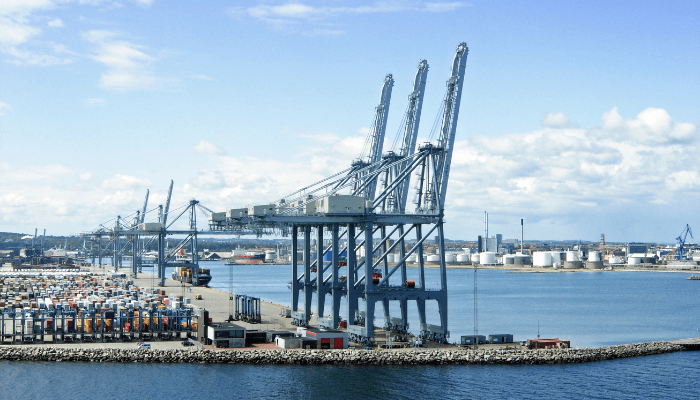
Located on the Aarhus Bay on the eastern shore of Jutland, Aarhus Port is the biggest and busiest container port in Denmark, handling more than 60 per cent of its container traffic. Strategically positioned on the Baltic Sea, it is close to the main manufacturing and industrial area of western Denmark. It is the only port in the country capable of accommodating the largest container ships in the world.
It is directly linked to the European Motorway E45 and the international airport. Approximately 11,290,000 tonnes of cargo, 400,000 TEUs and over 8000 ships and RORO ferries are handled at the port every year.
A major bulk port, it exports agro-based products, dairy, vegetable oils, packed meat, condensed milk, furniture and machinery and imports grains, coal, fodder, fertilisers, soya beans, timber and copra oil. Aarhus has trade relations with principal European ports and also the Far East and the eastern Mediterranean region.
Port Terminals
The port of Aarhus has 6 specialised terminals consisting of a total quay length of 8.8 km, handling containers, bulk, liquid cargo and passengers. The port incorporates a huge industrial complex housing 150 private companies. According to a survey conducted by Syddansk University, port-related activities have generated more than 10,000 jobs in the last two years.
The ferry terminal covers over 15 hectares and serves around 1,300,000 passenger cars and more than 2.5 million people annually. The Bulk and multi-terminal handles grains, foodstuff, coal and project cargo. Five Panamax-size vessels can be unloaded at this terminal simultaneously using gantry cranes equipped with a double-arm tilting system. Sand and gravel are discharged at the Omni Terminal while vegetable and mineral oils are handled at the oil terminal fitted with an advanced piping system.
2. Port of Copenhagen
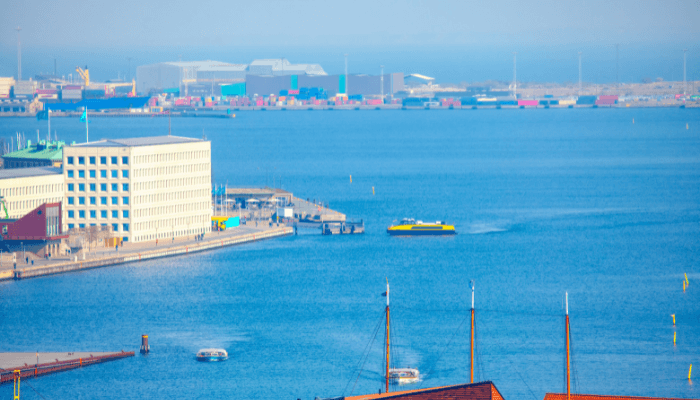
Copenhagen Port lies on the eastern coast of Sjaelland and was merged with Malmo Port to create the Copenhagen Malmo Port. It deals with consumer goods, building materials, vehicles, aviation fuel, and miscellaneous cargoes. The port is divided into an Inner Harbour, North Harbour and the Provestenen harbour. More than 8000 ships, 15,000,000 tonnes of cargo and over 194,000 TEUs are handled at the port every year.
An important financial and commercial centre serving the Scandinavian-Baltic region, the Copenhagen port houses several international corporations in its Freeport located in the North Harbour.
The city has a strong services sector driven by the IT industry, employing more than 100,000 professionals. Characterised by high wages and an equally high taxation system, it is one of the most expensive cities in Europe.
Port Specifications
The port covers 200 hectares of land area with a 16.5 km berthing line and 35 km of railway tracks. It has 10 wharves for accommodating Panamax-size ships and two container terminals spanning 250,000 m2 with a water depth of 9.5 m. Feeder ships carrying consumer goods from Hamburg, Rotterdam and Bremerhaven arrive at the terminal regularly.
The bulk terminal is the largest facility in eastern Denmark equipped with a 650 m long quay and an 18-hectare storage area. The oil terminal has 8 quays and numerous storage tanks for meeting regional and international fuel requirements. It also stores transit oil and supplies jet fuel to Copenhagen airport.
The RORO terminal is equipped with modern handling equipment for transporting automobiles to Sweden, Russia, Europe and other Baltic countries. Ferries plying to and from Poland, Norway and Germany also dock at this terminal, handling over 700,000 passengers annually.
The port has sufficient storage space including 200,000 m2 of warehouse area and tanks for keeping 2 million m3 of liquid bulk.
3. Port of Grenaa
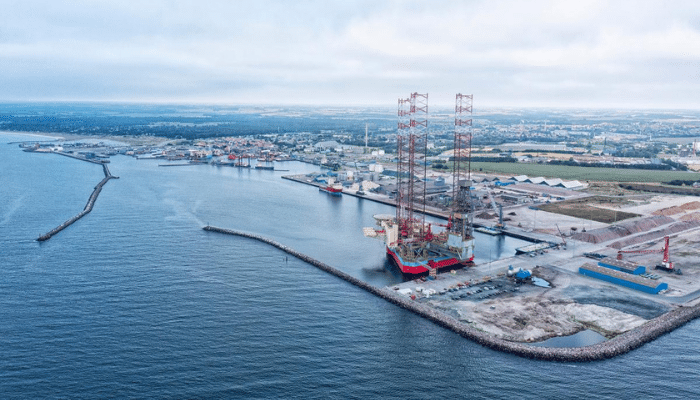
Grenaa Port is located on the eastern coast of Jutland, just 60 kilometres from the port of Aarhus. It is operational throughout the year and has a natural harbour divided into six basins. Grains, seeds, paper and stone are principal exports while major imports comprise coal, phosphates, saltpetre, chemicals, wood pellets, oil, wood chips, logs and paper pulp. More than 1000 vessels, 1,450,000 tonnes of cargo and 60,500 TEUs are handled at Grenaa Port every year.
Positioned centrally, Grenaa is closest to the shipping routes passing through the Kattegat strait. It is an important commercial and industrial port serving diverse business segments. Grenaa has grown from a small fishing port to an international trade hub, having the know-how and equipment for serving the offshore wind industry. It has an ideal layout for storing wind turbines and a designated assembly area, directly accessible to the quayside offering ease of transportation.
It also handles bulk, and project cargo, and houses waste recycling plants. Bunkering, container stacking and ship repair services are also offered at its dockyard.
The port covers 1,430,000 m2 of land area with a total quay length of 2500 m and alongside depths of 11 m. It has 25 warehouses covering 52,500 m2 and a 32,000 m2 open storage area.
It has a service area, a RORO terminal consisting of two wharves and a ferry terminal possessing 3 passenger berths. The port can store about 100,000 m3 of petroleum and its derivatives in its tank farm.
In 2020, the Denmark Maritime Authority announced the Grenaa port expansion project. The port surpassed its capacity in 2018 and 2019, making expansion urgent for handling increasing cargo traffic. Thus, an additional 17,000 sq m of land would be reclaimed for constructing a 350m-long quay and a 27,000 m2 operational area for handling offshore installations.
4. Port of Esbjerg
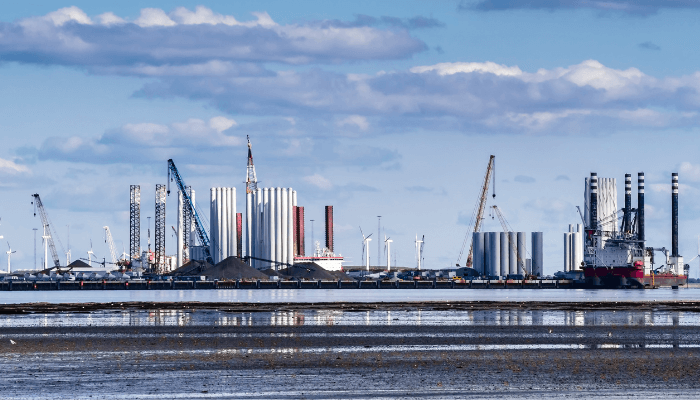
Esbjerg port lies on the western coast of the Jutland peninsula in the southwestern Syddanmark region of Denmark, sheltered by the island of Fano. Operational since the Viking era, it is an important centre for the oil and offshore drilling industry. It emerged as a major cargo port in 2019 by handling 204,000 tons of general cargo, 28,000 TEUs and 325,000 tonnes of coal.
A well-equipped port, it can handle diverse cargo types including RORO, fossil and liquid fuels, seafood, canned foodstuff and aggregates. Approximately, 17,800 vessels, 4,700,000 tonnes of cargo, 238,000 TEUs and 1,850,000 passengers are handled at the port annually. Additionally, Esbjerg is a financial and trading hub housing over 200 companies.
Port Characteristics
Esbjerg port covers 3.5 million square metres of land area out of which 1.5 million square metres are leased to private operators. It has a 10-kilometre quay length with depths ranging from 5 to 15 m.
It has many specialised wharves dedicated to specific cargoes. For instance, the Tauruskaj pier is 380 m long and handles offshore bulk cargo while the Australienkaj wharf handles fertilisers. Parcels are handled at the 420m long Europakaj dock.
Containers are dealt with at the Vestkraftkaj wharf. The Frankrigskaj dock has storage facilities for handling refrigerated and frozen cargoes. Englandskaj berth accommodates passenger ships and the Faegre Haven wharf handles ferries and barges.
Covering 235 metres, the Tvaerkaj berth handles RORO and a few containers while the Oliebro dock deals with liquid bulk cargo on its 2 tanker jetties equipped with a powerful pumping system and 6 storage tanks.
5. Port of Odense
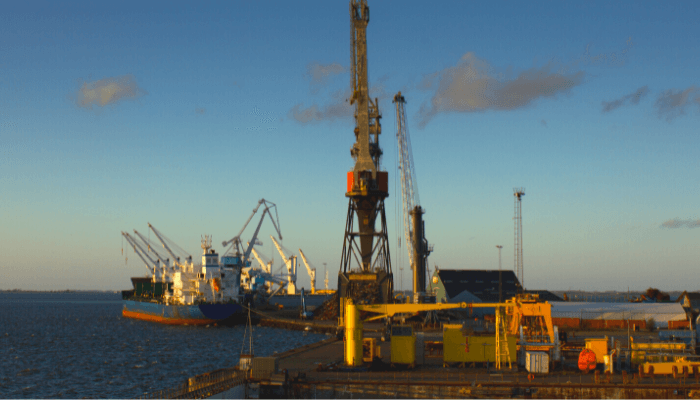
Odense Port ranks among the biggest ports of Denmark and consists of a commercial harbour and the Lindo industrial area. Located on Funen island, southwest of Kattegat Strait, it exports agricultural goods, general cargo, machinery, flour and foodstuff. Major imports comprise cereals, grains, coal, fertilisers, gravel, iron, kaolin, LPG, paper, petroleum products, salt and timber. Approximately 2,000,000 tonnes of cargo and 15,600 TEUs are handled at the port annually.
It spans 4 million square metres and has a 3000 m2 heavy load area. Nestled between the North Sea and the Baltic Sea, it has the second-largest shipbuilding facility in the country. Odense Port works at its optimum capacity for serving its clients hailing from the offshore energy sector. It has sufficient storage facilities and equipment for unloading heavy machinery and offers maritime services like bunkering, transhipment etc.
The main port area has three wharves stretching around 3450 metres and the harbour terminal has a quay measuring 630 m with a depth of 11 m. Apart from three parking spaces, it has a 1200 m2 warehousing area and many silos spread over 1000 m2 of ground area.
6. Port of Fredericia
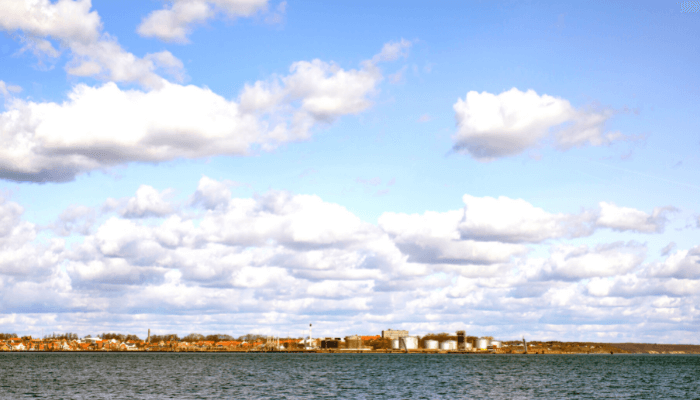
Located on the southeastern shore of Jutland, Fredericia port records one of the largest cargo turnovers among all ports and terminals of Denmark. It remains ice-free throughout the year and has specialised berths for shipping grains, dairy products, crude oil, biofuels, LPG, fertilisers, gravel and stone. Imports of steel, wood, timber, salt, phosphate, pyrites, nails, sodium sulphite and bitumen are also handled. Approximately 2,550 vessels, 16,900,000 tonnes of cargo and 21,800 TEUs pass through the port annually.
It is connected to the European Transport Corridor and the regional railway network, allowing for convenient handling and transhipment of cargoes, especially RORO.
Fridericia’s container terminal is one of the largest in Southern Denmark with shipping lines to all the major European and Asian ports. The ferry terminal operates a regular ferry service to and from Lithuania and other neighbouring regions.
Oil and Natural gas reserves abound and the country extracts billions of gallons of oil from the North Sea. The port’s Crossbridge Energy oil refinery situated on the port premises ships oil and petroleum products from the port’s oil terminal.
It has a warehouse capacity of 155,000 tonnes, specialised bulk storage areas and numerous quays with a water depth of 15 m. The warehouses are fitted with pressure-resistant sides and high-tech machines for drying grains and cereals before storing them. The port has fully-functional modern equipment including five luffing cranes, four mobile harbour cranes, forklifts, trailers and reach stackers.
Disclaimer: The authors’ views expressed in this article do not necessarily reflect the views of Marine Insight. Data and charts, if used, in the article have been sourced from available information and have not been authenticated by any statutory authority. The author and Marine Insight do not claim it to be accurate nor accept any responsibility for the same. The views constitute only the opinions and do not constitute any guidelines or recommendations on any course of action to be followed by the reader.
The article or images cannot be reproduced, copied, shared or used in any form without the permission of the author and Marine Insight.
Do you have info to share with us ? Suggest a correction
Latest Maritime Knowledge Articles You Would Like:
Subscribe To Our Newsletters
By subscribing, you agree to our Privacy Policy and may receive occasional deal communications; you can unsubscribe anytime.















